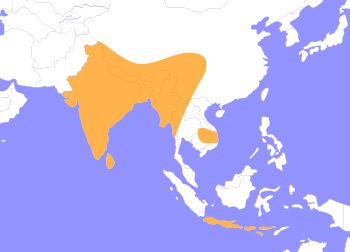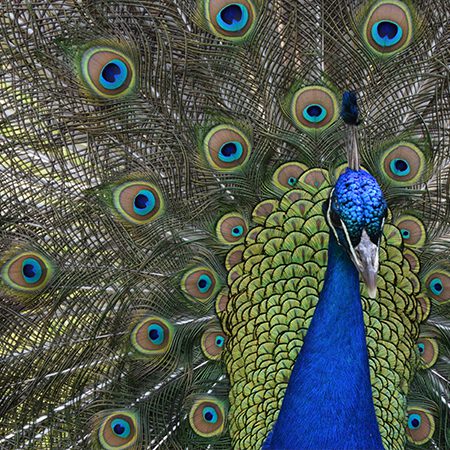Peafowl (Indian)
Pavo cristatus
Indian blue peafowl are an incredibly distinguished species of bird. They are best known for their unique plumage, which only shows up in the males. They have a rich blue coloration on their feathers throughout most of her body. Their wings have black and white markings and brown primaries. Of course, the most extravagant part of their body is their tail feathers. They have long, green feathers (which can reach almost four feet in length) that end in an eye-like design made of greens, blues, browns, and golds. These dramatic feathers can be fanned out wide behind the male when he is trying to impress females. He will also shake his rump and call out to get their attention. Males spend much of their energy growing their elaborate tails every year, as they will lose their tail feathers at the end of every mating season. Females, on the other hand, are a drab brown with some green iridescence on their neck. Both sexes have a bunch of crest feathers atop their head. There are other color variations of peafowl, including an all white (but not albino) and a partial white form.
They are considered the largest flying bird because of their tail feathers. Peafowl do not fly often, mostly just to get up into trees; they are non-migratory. Their lifespan can be from 10-20 years, or even longer if they avoid predation. They are very vocal animals, especially during mating season or if someone enters their territory. Their calls are very loud and can be heard from great distances.

Indian Peafowl are native to the Southeast Asiatic region, ranging across India.
HABITAT -They are found in deciduous, open forests in Southeast Asia.
DIET -They are omnivorous, eating frogs, snakes, flowers, and their favorite - termites!
FUN FACT -They will ingest pebbles to help grind their food.
SOCIAL BEHAVIOR -They are mainly solitary but create harems during mating season.
ACTIVITY -They are diurnal, roosting in high trees to sleep at night.
PREDATORS -Civets, large cats, and wild dogs are known to eat them.
SIZE -They can weigh 6-12 lbs and be 3-7 ft in length.
RELATIVES -They are in the same family as turkeys and grouse.
CONSERVATION -They are listed as Least Concern under the IUCN Red List.
Cub Creek Animal Care Information
Housing - Our peafowl mainly live as free roaming animals around camp. They can explore a wide area and find shelter in many places when they need. Some of our peafowl are kept in our Aviary because they are too young or unique to live outside. This is where you’ll find our white peafowl. These birds are housed in a multilayer outdoor hut that has plenty of places to perch.
Diet - All our peafowl are fed game bird finisher (when the chicks are born in summer, game bird grower is mixed in). The free roaming ones can also hunt on their own for extra food. In the Aviary, they have access to fresh water daily while the rest have many different water sources around camp to choose from.
Enrichment - Being able to roam around camp gives the peafowl plenty to do as they can explore and entertain themselves. In the Aviary, our peafowl live with other species of birds, including pigeons, farm chickens, and silkie chickens. This multi-species environment gives the birds plenty of interaction to enrich them every day.

